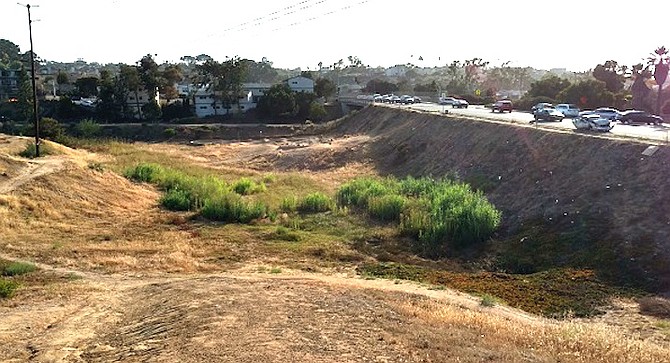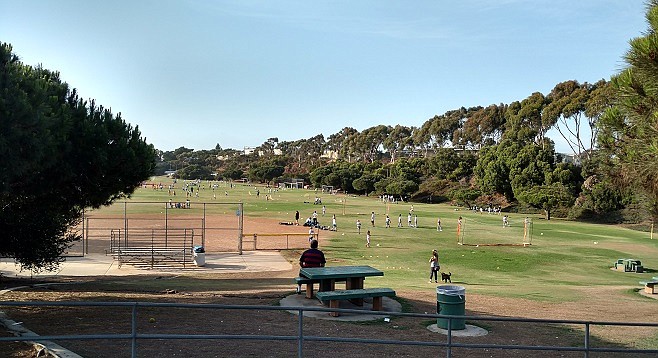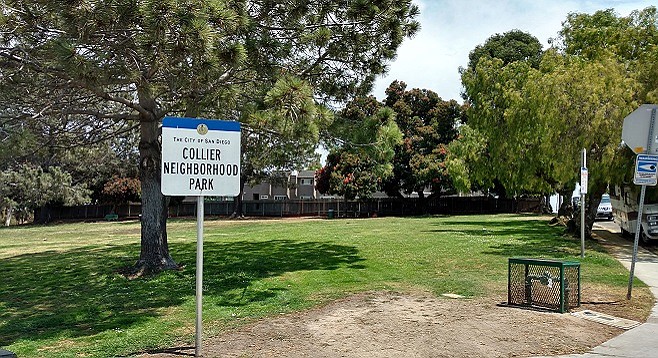 Facebook
Facebook
 X
X
 Instagram
Instagram
 TikTok
TikTok
 Youtube
Youtube

Since learning about the revival of a decades-long plan to develop affordable housing on a five-acre parcel at the intersection of Famosa and Nimitz Boulevards, Point Loma residents have been voicing stiff opposition to any proposed construction.

Local concerns have included increased traffic, potential for declining home values and increased crime if families with lower incomes move in, and loss of the last piece of unimproved open space in the area. Some residents are questioning whether the city has the authority to pursue any kind of development on the site at all.

In 1909, David Charles Collier, a real estate magnate responsible for establishing the public utilities and streetcar system that enabled the development of Ocean Beach, gave a 60-acre parcel of land to the city as parkland "for the children" of the Point Loma peninsula.
The land sat largely undeveloped for decades, though it served as the first home for the Door of Hope, a housing facility for single mothers.
Later, a 1956 citywide ballot measure granted the city manager authority to sell off Collier Park "upon such terms and conditions as may be deemed by the City Council to be in the best interests of the people." The measure was sold to voters at the time as a means to transfer part of the property for construction of Collier Junior High School (later renamed Correia Middle School), ostensibly keeping true to Collier's "for the children" wishes.
Some portions of Collier Park eventually became parkland – Bill Cleator Park includes a small playground area along with a series of fields that serve as the home of Peninsula Little League. Across Nimitz lies the Point Loma Native Plant Garden, Ocean Beach Community Garden, and a small patch of grass actually bearing the name Collier Park. Other land was sold off to apartment builders, a church, and the YMCA – the five acres along Famosa are the last bit of Collier's grant that remains undeveloped.
In 1981, the city transferred the land to the San Diego Housing Commission with a provision that it was to be used to build low-income housing. Although the commission made several attempts over the following years to partner with a developer for the site, a project never materialized. In addition to opposition from locals the site itself, once part of the Famosa Slough wetlands, proved challenging due to its steeply-sloped topography and low elevation.
The latest development proposal, the first in more than a decade, aroused curiosity in Catherine Bendixen, a homeowner in the neighboring Park Point Loma townhome complex.
"My search started with the San Diego Historical Society, but they had nothing," Bendixen begins. "They told me that the city had asked for all of their records to be returned, so I did a request through the city for the [original Collier land grant] documents I got just a map back, nothing else. The issues began when I found the 1981 deed transferring the property from the city to the housing authority."
Her findings have led Bendixen to believe that, in its current state of seeming legal limbo, no party exists with the authority to either build the 78 "workforce" housing units being proposed for the site or to sell it off to private developers, which the housing authority has warned is a possibility should their own project stall. There's also a discrepancy in how the units are defined.
"The ordinance calls for low-income housing rather than just affordable housing, which is my main sticking point right now," Bendixen said. "Coupled with the housing authority's resolution, I believe their hands are tied when it comes to selling the property."
At a presentation in June, Housing Commission representatives focused on housing that could be considered "affordable," that definition includes households with an income of up to 120% of the area median, or about $115,000 for a family of four. The more restrictive "low-income" category which is referenced in site documents must be affordable to those making only 80% of the median, roughly $77,000 per year.
"You can't sell it to developers, you have to either build low-income housing or leave it alone as open space," Bendixen concludes. "I see the city taking the land back as a park, as they wanted to do in 2012, as a great solution. In the worst case scenario, I'll get the foundation ready because if they do attempt to sell to a private entity I think we have enough people in Park Point Loma who have equity and would be interested in having that conversation."
Legal issues aside, sparks have continued to fly. After the Peninsula Community Planning Board in June rescinded a 2017 letter recommending the Famosa property to Lori Zapf as ideal for affordable development, at its July meeting board members approved a new letter that reaffirms support for affordable housing while officially taking no position in favor of or opposing development on Famosa.
The move drew criticism from attendees, many of whom favor open space as the only acceptable outcome and expressed concern that the letter's praise for "workforce housing" could be construed as support for continuing plans to develop. The matter appears likely to continue occupying an outsized portion of the board's time in the months to come.


Since learning about the revival of a decades-long plan to develop affordable housing on a five-acre parcel at the intersection of Famosa and Nimitz Boulevards, Point Loma residents have been voicing stiff opposition to any proposed construction.

Local concerns have included increased traffic, potential for declining home values and increased crime if families with lower incomes move in, and loss of the last piece of unimproved open space in the area. Some residents are questioning whether the city has the authority to pursue any kind of development on the site at all.

In 1909, David Charles Collier, a real estate magnate responsible for establishing the public utilities and streetcar system that enabled the development of Ocean Beach, gave a 60-acre parcel of land to the city as parkland "for the children" of the Point Loma peninsula.
The land sat largely undeveloped for decades, though it served as the first home for the Door of Hope, a housing facility for single mothers.
Later, a 1956 citywide ballot measure granted the city manager authority to sell off Collier Park "upon such terms and conditions as may be deemed by the City Council to be in the best interests of the people." The measure was sold to voters at the time as a means to transfer part of the property for construction of Collier Junior High School (later renamed Correia Middle School), ostensibly keeping true to Collier's "for the children" wishes.
Some portions of Collier Park eventually became parkland – Bill Cleator Park includes a small playground area along with a series of fields that serve as the home of Peninsula Little League. Across Nimitz lies the Point Loma Native Plant Garden, Ocean Beach Community Garden, and a small patch of grass actually bearing the name Collier Park. Other land was sold off to apartment builders, a church, and the YMCA – the five acres along Famosa are the last bit of Collier's grant that remains undeveloped.
In 1981, the city transferred the land to the San Diego Housing Commission with a provision that it was to be used to build low-income housing. Although the commission made several attempts over the following years to partner with a developer for the site, a project never materialized. In addition to opposition from locals the site itself, once part of the Famosa Slough wetlands, proved challenging due to its steeply-sloped topography and low elevation.
The latest development proposal, the first in more than a decade, aroused curiosity in Catherine Bendixen, a homeowner in the neighboring Park Point Loma townhome complex.
"My search started with the San Diego Historical Society, but they had nothing," Bendixen begins. "They told me that the city had asked for all of their records to be returned, so I did a request through the city for the [original Collier land grant] documents I got just a map back, nothing else. The issues began when I found the 1981 deed transferring the property from the city to the housing authority."
Her findings have led Bendixen to believe that, in its current state of seeming legal limbo, no party exists with the authority to either build the 78 "workforce" housing units being proposed for the site or to sell it off to private developers, which the housing authority has warned is a possibility should their own project stall. There's also a discrepancy in how the units are defined.
"The ordinance calls for low-income housing rather than just affordable housing, which is my main sticking point right now," Bendixen said. "Coupled with the housing authority's resolution, I believe their hands are tied when it comes to selling the property."
At a presentation in June, Housing Commission representatives focused on housing that could be considered "affordable," that definition includes households with an income of up to 120% of the area median, or about $115,000 for a family of four. The more restrictive "low-income" category which is referenced in site documents must be affordable to those making only 80% of the median, roughly $77,000 per year.
"You can't sell it to developers, you have to either build low-income housing or leave it alone as open space," Bendixen concludes. "I see the city taking the land back as a park, as they wanted to do in 2012, as a great solution. In the worst case scenario, I'll get the foundation ready because if they do attempt to sell to a private entity I think we have enough people in Park Point Loma who have equity and would be interested in having that conversation."
Legal issues aside, sparks have continued to fly. After the Peninsula Community Planning Board in June rescinded a 2017 letter recommending the Famosa property to Lori Zapf as ideal for affordable development, at its July meeting board members approved a new letter that reaffirms support for affordable housing while officially taking no position in favor of or opposing development on Famosa.
The move drew criticism from attendees, many of whom favor open space as the only acceptable outcome and expressed concern that the letter's praise for "workforce housing" could be construed as support for continuing plans to develop. The matter appears likely to continue occupying an outsized portion of the board's time in the months to come.
Comments